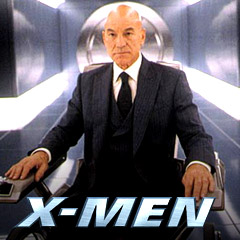
|
Super-Heroes X-Men |
(chronological by time period and film title) Introduction | Flash Gordon | Buck Rogers | Superman | Batman | Spider-Man | X-Men Marvel Cinematic Universe | The DC Extended Universe Iron Man | Hulk | Thor | Captain America | The Avengers | Guardians of the Galaxy Others: A - F | Others: G - N | Others: O - Z |
(chronological by time period and film title) |
||||||||||||||||||||||||||||||||||||||||||||||||||||||||||||||||||||||||||||||||||||||||
X-Men - this Marvel Comics series was created by artist Jack Kirby and Stan Lee. The superhero X-Men team first appeared in the comic book The X-Men # 1 (September 1963). In the initial issue (published bi-monthly), it told about five peace-keeping mutant characters, who were born with special mutant powers. They didn't require origin stories for the source of their unique, extraordinary powers. They were appealing because of the metaphoric sub-text about how they were different and were subject to prejudice and persecution. See Greatest Film Series Franchises - X-Men
The five original X-Men in the first comic book, The X-Men # 1 (September 1963), were five teenagers still learning to control their powers. They included Marvel Girl, Angel, Beast, Cyclops, and Iceman (see chart below). The telepathic teacher of the student mutants was Professor Charles Francis Xavier (aka Professor X) (with assistance from Cerebro, a powerful supercomputer), who taught the mutants in Xavier's School for Gifted Youngsters, located in Westchester County, New York. Professor X was first introduced in The X-Men # 12 (July 1965).
Other early X-Men comic book issues, such as The X Men # 4 (March 1964), introduced a Brotherhood of Evil Mutants. The group was led by Magneto who controlled magnetism and believed in mutant superiority and domination, with other supervillains such as:
There were no new stories involving the X-Men, from the spring of 1970 to mid 1975. [Note: Popular shape-shifting mutant Raven Darkholme/Mystique with blue skin and yellow eyes did not appear in the X-Men comics until 1978. She was usually portrayed as a super-villain.]
Then, there was a revival of the X-Men, evidenced in a special comic book issue, Giant-Size X-Men # 1 (May 1975) - with the first new X-Men story in five years. The issue served as a link between the original X-Men and a new team of X-Men. The new X-Men team, making their first appearances in Giant-Size X-Men # 1 (May 1975) included Storm, Nightcrawler, Colossus, and Thunderbird, and Wolverine also joined the team (see more below). They joined two previous members, including Banshee and Sunfire. In the first story, Cyclops explained that something strange had happened to the five original X-Men members (plus Havok and Polaris, minus Beast) who were on a mission to Krakoa (a South Pacific island), to investigate a new mutant menace. Marvel then began publishing new issues of X-Men with The X-Men # 94 (August 1975) - and these new X-Men became extremely popular, far surpassing the original X-Men in sales. See more below.
|
||||||||||||||||||||||||||||||||||||||||||||||||||||||||||||||||||||||||||||||||||||||||
| X-Men: Animated and TV Series | ||||||||||||||||||||||||||||||||||||||||||||||||||||||||||||||||||||||||||||||||||||||||
| Super-Hero Films | ||||||||||||||||||||||||||||||||||||||||||||||||||||||||||||||||||||||||||||||||||||||||
 
|
The Marvel Super-Heroes (1966) - TV series The first TV appearance of the X-Men was on this 1966 animated TV series. It was syndicated and first shown in the US in 1966, first airing on September 1, 1966, and running through December 1, 1966. It was a half-hour show. It was Marvel's first TV series. The series had limited, crude or minimal animation. The cartoons were made as a series of static comic-strip panel images, and only the lips of those speaking moved. The anthology series rotated between five stories of Marvel comic-book super-heroes: The Incredible Hulk, The Mighty Thor, Captain America, Iron Man and The Sub-Mariner. In each half-hour show (or episode), there were three separate seven-minute segments that focused on an individual super hero each day of the work week. Each segment was separated by a short description of one of the other four heroes featured in the series. Each of the superheroes was the star of 13 episodes (or 39 segments), adding to a total of 65 half-hour episodes for all five superheroes. The aquatic Sub-Mariner, also known as Prince Namor, was Prince of the sunken continent of Atlantis. John Vernon was the voice of The Sub-Mariner. The character would eventually join the X-Men in the comic books several decades later. In the 12th (of 13) Sub-Mariner episode titled "Dr. Doom's Day/The Doomed Allegiance/ Tug of Death," the X-Men guest-starred - but were referred to as "The Allies for Peace" (composed of Angel, the Beast, Cyclops, Iceman, and Marvel Girl). |
 
|
||||||||||||||||||||||||||||||||||||||||||||||||||||||||||||||||||||||||||||||||||||||
 
|
Spider-Man and His Amazing Friends (1981-1983) - TV series Another Marvel Productions animated TV series (aired on NBC-TV on Saturday mornings) ran for three seasons, from September 12, 1981 to November 5, 1983, with a total of 24 episodes.
The animated TV show was mostly about Spider-Man, although he was teamed up with two other 'Amazing Friends' superheroes: Iceman (Robert "Bobby" Drake) and Firestar. This made the Iceman the first X-Men character to have a regular role on TV. The X-Men themselves and other associated characters made appearances in several episodes of TV's Spider-Man and His Amazing Friends:
|

|
||||||||||||||||||||||||||||||||||||||||||||||||||||||||||||||||||||||||||||||||||||||
 
|
X-Men: Pryde of the X-Men (1989) - TV pilot This was a 30-minute (with commercials), animated TV pilot by Marvel Productions that was originally broadcast on September 16, 1989. It was narrated by X-Men co-creator Stan Lee. It was a self-produced pilot that Marvel hoped would become an animated X-Men TV series. This one-episode pilot for an ongoing X-Men animated series was not picked up. Mutant Kitty Pryde (aka Sprite) was the main character - she joined the X-Men team including Cyclops, Storm, Nightcrawler, Colossus, Wolverine and the Dazzler. Magneto was the main villain, with a Brotherhood Team of Mutants composed of Juggernaut, Toad, Pyro, the Blob and eventual X-Men member Emma Frost/The White Queen. |

|
||||||||||||||||||||||||||||||||||||||||||||||||||||||||||||||||||||||||||||||||||||||

|
X-Men (1992-1997) (aka X-Men: The Animated Series) - TV series This was Marvel's second attempt to broadcast an X-Men TV series, after the failure of X-Men: Pryde of the X-Men in 1989. It debuted on October 31, 1992 in the US on the Fox-TV as part of its Fox Kids Saturday morning lineup. This Fox-Kids animated TV series had a successful five-season run from 1992-1997, with a total of 76 half-hour episodes. X-Men was the longest-running Marvel Comics-based show, lasting a full 76 episodes.
The series, mostly a continuous narrative, featured a core X-Men team led by Professor X, similar to that of the early 1990s comic-books: Wolverine, Gambit, Beast, Cyclops, Jean Grey, Storm, Rogue, and Jubilee. The main villains or enemies included Magneto, The Sentinels and Sabretooth. It was the main TV series to air before the first feature-length X-Men film in 2000. |
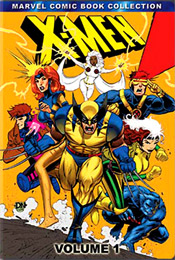
|
||||||||||||||||||||||||||||||||||||||||||||||||||||||||||||||||||||||||||||||||||||||

|
Spider-Man (1994-1998) - TV series There was some X-Men cross-over with the animated Spider-Man (1994-1998) TV series, when Spider-Man sought the X-Men's help to stave off his progressing mutation. Some of the X-Men characters and Professor Xavier appeared on the Spider-Man animated TV series during its five-year run from 1994-1998, in these episodes:
|
|||||||||||||||||||||||||||||||||||||||||||||||||||||||||||||||||||||||||||||||||||||||

|
Generation X (1996) This was a full-length, live-action TV movie (a TV movie pilot that never materialized any further) directed by Jack Sholder, marking the first ever live-action portrayal of any of the X-Men characters. It was based on the Marvel Comics comic-book series Generation X, a spin-off of the X-Men franchise, created by writer Scott Lobdell and artist Chris Bachalo. The plotline was about a team of young students (mutated teens with super-powers) in super-hero training. They were not mentored by X-Men founder Charles Xavier at his New York estate, but by Banshee (Jeremy Ratchford) and former super-villain Emma Frost (Finola Hughes) at a splinter school in western Massachusetts. It originally aired on the Fox-TV network on February 20, 1996. Future X-Men characters included Emma Frost/The White Queen (Finola Hughes) and Sean Cassidy/Banshee (Jeremy Ratchford) - both seen in X-Men: First Class (2011). Also appearing was Jubilee (Heather McComb). The villain was a silly mad scientist, Doctor Russel Tresh, portrayed by Matt Frewer (Max Headroom). |

|
||||||||||||||||||||||||||||||||||||||||||||||||||||||||||||||||||||||||||||||||||||||

|
X-Men: Evolution (2000-2003) - TV series This re-imagining of the X-Men plotline was an animated TV series which aired on The Kids-WB. The fan favorite comic book title was brought onto the TV screen, somewhat faithfully. There were 4 seasons and a total of 52 half-hour color episodes. (There were 4 two-part episodes, appearing at the conclusion of each season.)
In this teen-oriented series, most of main cast members had been turned into kids (with the exception of Wolverine, Professor X, and a few select others). The six X-Men mutants included: Cyclops, Jean Grey, Nightcrawler, Kitty Pryde (using her Shadowcat codename), Rogue, and Spyke (a new original character created specifically for the series), and later, Angel and Iceman. The students were taught by Professor X, Wolverine and Storm, at Xavier's School for the Gifted. |

|
||||||||||||||||||||||||||||||||||||||||||||||||||||||||||||||||||||||||||||||||||||||

|
Wolverine and the X-Men (2008-2009) - TV series Wolverine/Logan (voice of Steve Blum) headlined this X-Men animated TV series. It only aired for a single season, with a total of 26 episodes.
The first episode, "Hindsight," was a 3-part episode, as was the last episode, "Foresight." The series opened with an explosion at the Xavier mansion, experienced by Wolverine, Jean Grey, and Professor Xavier. Then the timeline jumped to a year later, with flashbacks revealing that the X-Men had disbanded following the explosion, and the disappearance of the Professor and Jean Grey. Meanwhile, the government's fascistic Mutant Response Division (MRD, referred to colloquially as the "Mardies") was attempting to capture and imprison all mutants. It was the fourth adapted, X-Men related animated TV series, following:
|

|
||||||||||||||||||||||||||||||||||||||||||||||||||||||||||||||||||||||||||||||||||||||

|
The Super Hero Squad Show (2009-present) - TV series This animated TV series by Marvel Animation, targeted at younger audiences, included many of the X-Men characters, including Wolverine, Professor X, Storm, Cyclops, Jean Grey, Iceman, Colossus and others from the expanded Marvel Comics universe. It aired for two seasons on The Cartoon TV Network, from September 14, 2009 to October 13, 2011, with 26 episodes per season.
It was based upon the Hasbro line of toy action figures, in the Marvel Super Hero Squad. It portrayed the Avengers, the X-Men, and various other characters in the Marvel Universe. |

|
||||||||||||||||||||||||||||||||||||||||||||||||||||||||||||||||||||||||||||||||||||||
| The X-Men Film Franchise: See Greatest Film Series Franchises - X-Men | ||||||||||||||||||||||||||||||||||||||||||||||||||||||||||||||||||||||||||||||||||||||||
|
There were originally three X-Men feature-length films (from 2000 to 2006) from 20th Century Fox. X-Men (2000) The original trilogy was then followed by a prequel film in 2011, a sequel in 2014, and another sequel in 2016. X-Men: First Class (2011) A spin-off series (a trilogy of three films in 2009, 2013, and 2017) involved one of the X-Men characters, Wolverine/aka James Howlett or Logan. X-Men Origins: Wolverine (2009) Another spin-off character was Deadpool, appearing in his own films in 2016 and 2018. Deadpool
(2016) The next spin-off character was Phoenix (or Jean Grey), appearing in her own feature film in 2019. It was a direct sequel to X-Men: Apocalypse (2016). Dark Phoenix (2019) |
||||||||||||||||||||||||||||||||||||||||||||||||||||||||||||||||||||||||||||||||||||||||
| Super-Hero Films | ||||||||||||||||||||||||||||||||||||||||||||||||||||||||||||||||||||||||||||||||||||||||
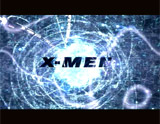
|
X-Men (2000) This was the first X-Men feature film (not a made-for-TV movie). It was the lowest-grossing film of the original trilogy. The original trilogy of three installments was composed of: Director Bryan Singer's surprise hit X-Men (2000) was about Professor Charles Xavier's (Patrick Stewart) school of mutant X-Men that fought against villainous forces:
|

|
||||||||||||||||||||||||||||||||||||||||||||||||||||||||||||||||||||||||||||||||||||||

|
X2: X-Men United (2003) Director Bryan Singer's X2: X-Men United (2003) was an inevitable (and superior) sequel, with the X-Men battling against the mysterious anti-mutant militant Col. William Stryker. It was a true sequel, with most of the characters returning from the original film, with some additional ones. Alan Cumming took the role of Nightcrawler. Two new young X-Men were introduced: (1) Rogue's (Anna Paquin) mutant student boyfriend Iceman/Bobby Drake (Shawn Ashmore) (he had only a minor role in the first film), and (2) their angry young friend Pyro/John Allerdyce (Aaron Stanford). It was the second highest-grossing film of the original trilogy. |

|
||||||||||||||||||||||||||||||||||||||||||||||||||||||||||||||||||||||||||||||||||||||
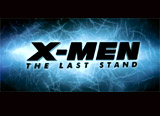
|
X-Men: The Last Stand (2006) (aka X3) Director Brett Ratner's X-Men: The Last Stand (2006) - the third film in the original series, was about the uncovering of the Dark Phoenix force (a Marvel comics entity Jean Grey, class 5 mutant portrayed by Famke Janssen). It was the highest-grossing (domestic) film of the original trilogy - and of the entire X-Men series of franchise films until Deadpool (2016) overtook the lead. |

|
||||||||||||||||||||||||||||||||||||||||||||||||||||||||||||||||||||||||||||||||||||||

|
X-Men: First Class (2011) Director Matthew Vaughn's mutant origin story X-Men: First Class (2011) was a prequel to the first three films. It was the 5th film in the entire X-Men series. It was set in 1962, the year of the Cuban Missile Crisis. 20th Century Fox envisioned this film as the first film in a new trilogy. It presented the beginnings and origins of the entire X-Men saga, describing the youths of the two main protagonists and their collaboration against a common powerful adversary, before they split off and became mortal arch-enemies due to their ideological differences. The two main protagonists were Professor Charles Xavier or "X" (James McAvoy) and Eric Lensherr/Magneto (Michael Fassbender). It showcased the early friendship of the two and how Professor X became a peaceful revolutionary leading the X-Men, while the Professor's future rival-nemesis separated and led the Brotherhood of Mutants. |

|
||||||||||||||||||||||||||||||||||||||||||||||||||||||||||||||||||||||||||||||||||||||
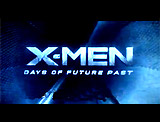
|
X-Men: Days of Future Past (2014) The next film in the series was X-Men: Days of Future Past (2014) - again directed by Bryan Singer, with a $200+ million budget, making it the priciest and most complicated X-Men film to date. This was director Bryan Singer's third X-Men film, following his helming of the 2000 and 2003 films. It was a sequel to both X-Men: The Last Stand (2006) and X-Men: First Class (2011). It was the 7th installment of the X-Men series franchise.The superhero film combined the casts of both the original X-Men Trilogy (including Hugh Jackman as Wolverine, Patrick Stewart as Prof. Charles Xavier, and Ian McKellen as Erik Lehnsheer/Magneto) and Matthew Vaughn's prequel X-Men: First Class (2011) (featuring James McAvoy as a younger Xavier, Michael Fassbender as Magneto, and Jennifer Lawrence as Raven/Mystique). The story involved time-travel - the X-Men had to alter the past to save the future - a dystopia ruled by robots (known as Sentinels) who were rounding up mutants in camps for extermination. A distant-future Wolverine consciousness was sent back to the 1970s by the X-Men to prevent war, by brokering peace and uniting friends-turned-adversaries Charles Xavier and Magneto, in order to prevent the rise of the Sentinels. With a number of new mutant characters, including Bishop (Omar Sy) who could absorb energy, Blink (Fan Bingbng) with the ability to open teleportation portals, Quicksilver (Evan Peters) - a 70s-era mutant with super-speed, Sunspot (Adan Canto) who could harness solar power with powerful heat blasts, and Warpath (Booboo Stewart) - a Native American mutant warrior (aka James Proudstar) with super-speed and strength. |

|
||||||||||||||||||||||||||||||||||||||||||||||||||||||||||||||||||||||||||||||||||||||

|
X-Men Apocalypse (2016) X-Men Apocalypse (2016) was directed by Bryan Singer - it was his fourth X-Men film. The 2016 superhero film served as a sequel to X-Men: Days of Future Past (2014). It served as the final film in the X-Men: First Class story arc trilogy, which consisted of X-Men: First Class (2011) and X-Men: Days of Future Past (2014). It was the 9th installment in the entire X-Men film series. The story took place in a reset timeline, although it was also considered a sequel. For example, actor Kodi Smit-McPhee portrayed a younger version of Nightcrawler. The superhero film was a carry-over of the brief post-credits sequence in X-Men: Days of Future Past (2014) - in ancient Egypt, a crowd was chanting (in a foreign language) and bowing to a hooded figure wearing a striped robe - a bluish, skinny mutant named En Sabah Nur (aka Apocalypse, the very first mutant) (Brendan Pedder), who telekinetically elevated building blocks to forge ancient pyramids. Apocalypse's minions - the four Horsemen of Apocalypse (Death, Famine, Pestilence, and War), watched on horseback from afar on a sand-dune. In this installment, the renegade, villainous mutant En Sabah Nur awakened in the year 1983 and had take-over plans to destroy civilization. The X-Men assembled to deter and defeat him and his band of newly-assembled mutants as modern-day Horsemen. |

|
||||||||||||||||||||||||||||||||||||||||||||||||||||||||||||||||||||||||||||||||||||||
The Wolverine - the clawed X-Men hero Wolverine (born James "Logan" Howlett) had first debuted in the last 'teaser' panel of the comic book The Incredible Hulk # 180 (October 1974). His first full appearance was in the next issue The Incredible Hulk # 181 (November 1974), with a yellow and blue costume. Wolverine was created by writer Len Wein and Marvel art director John Romita, and was later enhanced by writer Chris Claremont and co-writer/artist John Byrne. The Wolverine was soon to become the most popular break-out character on the X-Men team. He was born in Canada in the late 1800s, and his main superhero abilities were due to his mutations - switchblade claws that emerged from the knuckles of each hand, and his ability to heal himself.
Shortly later, the clawed Canadian Logan/Wolverine was recruited as one Professor X’s gifted mutants in Giant-Size X-Men # 1 (May 1975). |
||||||||||||||||||||||||||||||||||||||||||||||||||||||||||||||||||||||||||||||||||||||||
| Super-Hero Films | ||||||||||||||||||||||||||||||||||||||||||||||||||||||||||||||||||||||||||||||||||||||||

|
X-Men Origins: Wolverine (2009) Director Gavin Hood's X-Men Origins: Wolverine (2009) was the first spin-off variation of the X-Men films. It was a derivative origin-story prequel with both Wolverine and Sabretooth. Wolverine was aka James Howlett or Logan (Hugh Jackman), with accelerated healing, enhanced senses, bone claws, and an adamantium skeleton (his bones had been fused with indestructible metal adamantium). It was the 4th installment in the entire X-Men series. It was the first stand-alone feature and origin story of the X-Men franchise, set about 20 years before the film trilogy. |

|
||||||||||||||||||||||||||||||||||||||||||||||||||||||||||||||||||||||||||||||||||||||
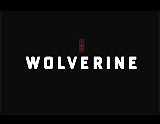
|
The Wolverine (2013) Director James Mangold's The Wolverine (2013) was a second spin-off film of Marvel's solo character - the immortal, self-healing, clawed mutant Wolverine. The first spin-off film from the main X-Men series was X-Men Origins: Wolverine (2009). This marked the 6th appearance of Hugh Jackman as the Wolverine/Logan, and Hugh Jackman's second solo turn as the razor-clawed mutant. It was also the first time that X-Men wasn't part of the film's title. This film was set long after all the existing trilogy entries in the X-Men series-franchise - after the events of X-Men: The Last Stand (2006). It was the 6th installment of the entire X-Men franchise. The immortal, self-healing mutant traveled to modern-day Japan to say farewell to dying friend Yashida, a wealthy tycoon, and found himself protecting sheltered, rich heiress Mariko (Japanese supermodel Tao Okamoto) from deadly opponents while struggling with his own immortality. The Wolverine fought off two mutant enemies, Marvel's Silver Samurai and Dr. Green - aka Viper (Svetlana Khodchenkova), and a host of Black Ninja Clan members and Yakuza (Japanese mafia members). |

|
||||||||||||||||||||||||||||||||||||||||||||||||||||||||||||||||||||||||||||||||||||||

|
Logan (2017) Logan (2017) was the third (and last) installment of the solo Wolverine franchise (or trilogy), again starring Hugh Jackman.The R-rated film (the first in the Wolverine series) was set within a new timeline established after the events of X-Men: Days of Future Past (2014) and X-Men: Apocalypse (2016). It served as a reboot rather than as a sequel to X-Men Origins: Wolverine (2009) and The Wolverine (2013). Director James Mangold had also directed the previous film in the sub-series, The Wolverine (2013). It was the 10th installment in the X-Men film series. After having played the role of Logan/Wolverine for 17 years, Hugh Jackman declared that this would probably be his final film. The film also marked Patrick Stewart's last significant portrayal of his character Professor Xavier. In this installment of the trilogy set in a dark future (in the year 2029) where mutants were basically extinct, Wolverine/Logan (Hugh Jackman) (aka James Howlett) was hiding out (on the Mexican border at El Paso, Texas) with seriously-ill and telepathic Professor Xavier (Patrick Stewart) suffering from brain disease, and serving as one of his caregivers. Their lives were soon to be affected by young and mysterious 11 year-old mutant Laura Kinney / X-23 (Dafne Keen), from the corrupt Alkali-Transigen Corporation. The main revelation was that she had been created from Logan's mutant DNA. |

|
||||||||||||||||||||||||||||||||||||||||||||||||||||||||||||||||||||||||||||||||||||||
Jean Grey (or Phoenix) - this X-Men spin-off character has been known by multiple names: Marvel Girl, Phoenix, and Dark Phoenix, and sometimes with a hyphenated name: Jean Grey-Summers. (In the original X-Men series - she was portrayed by Famke Janssen. In the storyline, she married Cyclops (Scott Summers), and was originally mentored by patriarchal Charles Xavier, and experienced a brief unrequited love affair with Wolverine.) In X-Men: Apocalypse (2016) set in 1983, the direct predecessor film to Dark Phoenix (2019), Sophie Turner played a younger version of Jean Grey, and returned to play the title character as an adult in the 2019 film. The mutant character first appeared in The X-Men # 1 (September 1963), as described further above, as "Marvel Girl" - created by writer Stan Lee and artist Jack Kirby. She exhibited numerous powers, including telekinesis, telepathy, and astral projection. Because of her considerable powers, Xavier had put psychic barriers around her so that she wouldn't accidentally unleash them. In her source story written by Chris Claremont and with artwork by Dave Cockrum in X-Men # 101-108 (October 1976 - December 1977), when she was returning from a mission to space, Jean was exposed to a lethal dose of radiation and the team's shuttle crash-landed in New York's Jamaica Bay. She survived and took the name of "Phoenix." Then in the next installment of the Dark Phoenix saga (again by writer Chris Claremont and artwork/writing by John Byrne), in The Uncanny X-Men # 129-138 (January - October 1980) a telepathic Mastermind in the Hellfire Club helped to unleash her full powers as the "Dark Phoenix."
|
||||||||||||||||||||||||||||||||||||||||||||||||||||||||||||||||||||||||||||||||||||||||
Dark Phoenix (2019) Writer/director Simon Kinberg's X-Men superhero film was the 12th released film in the entire X-Men series. The film was budgeted at $200 million, but performed poorly and received negative reviews. The tagline was "THE PHOENIX WILL RISE." It was a direct sequel to X-Men: Apocalypse (2016), set a decade later, with a number of the same characters (and stars portraying them):
Sophie Turner starred as the title character, an extremely powerful mutant with telepathic and telekinetic powers. When a solar flare hit the X-Men's space ship returning from a rescue mission, Jean survived but her uncontrollable powers were unleashed. She was taken over by a cosmic entity known as the Phoenix Force - and ultimately was transformed into the "Dark Phoenix." Dark Phoenix was previously adapted for the 1990s animated "X-Men" TV series, the 2009 animated series "Wolverine and the X-Men," and very loosely in X-Men: The Last Stand (2006). |

|
|||||||||||||||||||||||||||||||||||||||||||||||||||||||||||||||||||||||||||||||||||||||
Nightcrawler - one of Marvel's X-Men mutants (aka Kurt Wagner) first appeared in Giant-Size X-Men # 1 (May 1975) - a dark and evil character, blue-skinned, with a prehensile devil's tail, adhesive hands and feet, yellow eyes, pointed ears, a devout member of the Catholic faith, and with the ability to teleport long distances. Nightcrawler possessed two fingers on each hand, and three toes on each foot. Reportedly, Nightcrawler spent some time in Germany, in a Munich circus, and his mother turned out to be Mystique. Nightcrawler's first solo title was in Nightcrawler # 1 (November 1985).
|
||||||||||||||||||||||||||||||||||||||||||||||||||||||||||||||||||||||||||||||||||||||||
Deadpool - the origin of Deadpool (also known as "Merc with a mouth") was in the comics, introduced as "lethal" in the comic-book issue New Mutants # 98 (February 1991), created by writer Fabian Nicieza and artist Rob Liefeld. The name "Deadpool" was allegedly derived from the fifth Dirty Harry movie, The Dead Pool (1988). He was characterized by a full red body suit and head mask Known as Wade Wilson for an alias, Deadpool had been a former test subject of the Weapon X program, and became a self-professed member of the X-Men and the Avengers. He often broke the 4th wall - quipping to the audience.
Deadpool was depicted as unstable and unpredictable. |
||||||||||||||||||||||||||||||||||||||||||||||||||||||||||||||||||||||||||||||||||||||||
| Super-Hero Films | ||||||||||||||||||||||||||||||||||||||||||||||||||||||||||||||||||||||||||||||||||||||||

|
Deadpool (2016) This superhero comedy film, Deadpool (2016), was directed by Tim Miller and written by Rhett Reese and Paul Wernick. The film's title character was portrayed by Ryan Reynolds. It was the 8th installment in the X-Men film series. At the time, it quickly became the overall highest-grossing R-rated film, and the highest grossing X-Men film. The character of the vengeful anti-hero Deadpool, formerly known as Wade Wilson and possessing scarred skin, was originally villainous, but then became an anti-hero (mostly anarchic in his scandalous behavior). He had balletic agility, and the ability to regenerate. |

|
||||||||||||||||||||||||||||||||||||||||||||||||||||||||||||||||||||||||||||||||||||||
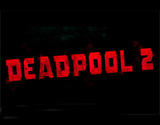
|
Deadpool 2 (2018) Director David Leitch's sequel was the second Deadpool tale about the foul-mouthed mutant mercenary Wade Wilson (Deadpool) (Ryan Reynolds). It was the 11th film in the X-Men film series. It told about how Deadpool joined a number of X-Men mutants known as X-Force:
Their goal was to protect an alienated, rebellious, pyrokinetic teen mutant known as Firefist/Russell Collins (Julian Dennison) from the all-powerful, cybernetic from-the-future Cable/Nathan Summers (Josh Brolin). |

|
||||||||||||||||||||||||||||||||||||||||||||||||||||||||||||||||||||||||||||||||||||||